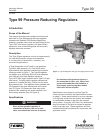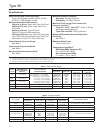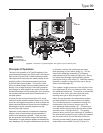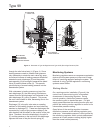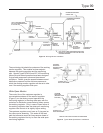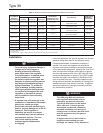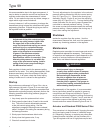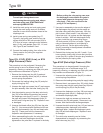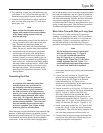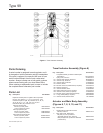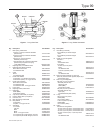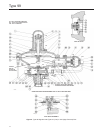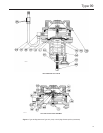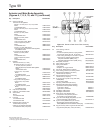
Type 99
4
Type 99 Regulator with Type 61HP (extra high pressure) Pilot
A2505
January 2008
Type 99
INLET PRESSURE
OUTLET PRESSURE
LOADING PRESSURE
ATMOSPHERIC PRESSURE
through the relief valve body (J) (Figure 4). Since
loading pressure needs to exceed outlet pressure
only moderately to stroke the main valve fully open,
a continued increase in loading pressure differential
extends the main diaphragm (E) and the pusher
post assembly (K) far enough to separate the bleed
valve (D) and the bleed orice (H). This permits
quick dumping of excess loading pressure into the
downstream system.
With a decrease in loading pressure on top of the
main diaphragm (E), the main spring (B) exerts an
upward force on the diaphragm rod connected to the
main diaphragm (E), pulling it upward. This moves
the main valve toward its seat, decreasing ow to the
downstream system.
Diaphragm (G) in the pilot valve acts as a sealing
member for the loading chamber and as a balancing
member to diaphragm (F). These two diaphragms are
connected by a yoke so any pressure change in the
pilot chamber has little effect on the position of the pilot
valve. Therefore, the active diaphragm in the pilot is
(F) and the pressure on the top side of this diaphragm
opposes the force of the pilot control spring (A).
Monitoring Systems
Monitoring regulators serve as overpressure protection
devices to limit system pressure in the event of open
failure of a working regulator feeding the system. Two
methods of using Type 99 regulators in monitoring
systems are as follows:
Working Monitor
On a working monitor installation (Figure 4), the
control line of the monitoring pilot is connected
downstream of the working regulator. During
normal operation, distribution pressure causes
the monitoring pilot to stand wide open. Full pilot
supply pressure enters the working monitor pilot and
permits the working monitor regulator to control at its
intermediate pressure setting.
Open failure of the working regulator increases
distribution pressure as the working regulator goes
wide-open. Intermediate pressure is then ignored by
the monitoring regulator, which controls downstream
pressure at its own pressure setting (slightly higher
than the normal control pressure).
Figure 3. Schematic of Type 99 Regulator with Type 61HP (Extra High Pressure) Pilot
DOWNSTREAM
CONTROL LINE
B
G
K
E
A
FLANGE
ADAPTOR
INLET PRESSURE
TUBING CONNECTION
H
J
D
C
F
RELIEF
VALVE
CAP
YOKE
LEG
YOKE
CAP
YOKE
CAP
RELAY
VALVE
54A2767-a
A2505
INLET PRESSURE
OUTLET PRESSURE
LOADING PRESSURE
ATMOSPHERIC PRESSURE
Type 99
A6469
January 2008
Type 99
INLET PRESSURE
OUTLET PRESSURE
LOADING PRESSURE
ATMOSPHERIC PRESSURE



